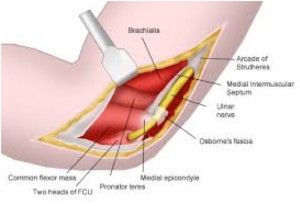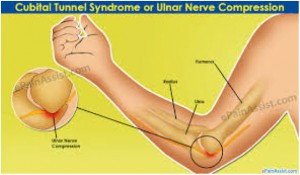Cubital Tunnel Release
 Cubital Tunnel Release, also called ulnar nerve entrapment is a condition caused by compression of the ulnar nerve in an area of the elbow called the Cubital Tunnel. Cubital Tunnel Syndrome is an injury to the ulnar nerve in the arm that can result in moderate to severe pain and numbness in the elbow and ring & little fingers. Untreated, can result in extreme pain and an unusable hand.
Cubital Tunnel Release, also called ulnar nerve entrapment is a condition caused by compression of the ulnar nerve in an area of the elbow called the Cubital Tunnel. Cubital Tunnel Syndrome is an injury to the ulnar nerve in the arm that can result in moderate to severe pain and numbness in the elbow and ring & little fingers. Untreated, can result in extreme pain and an unusable hand.
When the ulnar nerve is compressed or entrapped, the nerve can tear and become inflamed leading to various symptoms.
Preparation for Cubital Tunnel Release Surgery
Cubital Tunnel release surgery is a major operation that requires some preparation by the patient. Although severe complications are unlikely, it’s important to follow a few key guidelines to ensure your Cubital Tunnel Release Surgery goes well.
These guidelines are for information only and may not apply to your specific case. If your surgeon or hospital has not provided you with specific surgery-day guidelines, please ask for them.
- No food or drink after midnight the night before surgery
- You may brush your teeth and rinse with mouthwash, but do not swallow any liquids
- Do not use breath mints or chewing gum
- Take a shower or bath the night before or morning of your surgery
- Do not wear contact lenses; if you wear glasses, bring a case
- Leave all valuables at home
- No jewelry on the arm that will have surgery
- Wear a loose-fitting, button-up front shirt that will fit over your cast or brace
- Avoid tight pants or other clothing that will be difficult to put on after surgery
- Bring a pillow in the car to support your arm on the ride home
- Bring a copy of your pre-operation examination form
- Someone must bring you to the hospital, remain there during your surgery, and drive you home afterward
- Relax and remember that Cubital Tunnel Release Surgery should bring you relief
Cubical Tunnel Release Procedure
- The procedure is usually carried out as an outpatient in an ambulatory care setting
- General anesthesia or local anesthesia supplemented with neuroleptic analgesia is used
- Simple decompression of the ulnar nerve
- The incision is about 4 – 5 inches long centered at the elbow.
- The incision may be in back of the elbow over the course of the ulnar nerve or the incision may be curvilinear starting over the intermuscular above the elbow, passing anterior to the elbow and finishing over the flexor carpi ulnaris muscle
- The ulnar nerve is released by cutting the arcuate ligament
- The nerve is followed upward and released at the intermuscular septum
- The nerve is followed below the elbow into the flexor carpi ulnaris and released from any constricting bands (Figure 7C)
- The incision is then closed with sutures
- Decompression and anterior subcutaneous transposition of the ulnar nerve
- The curvilinear incision is used and the nerve released as described above
- The nerve is placed in front of the elbow
- A tunnel is then formed in the fatty tissue beneath the skin with a few absorbable sutures and the incision closed with sutures
- Medial epicondylectomy
- The simple decompression of the nerve is carried out
- The medial epicondyle in front of the nerve is removed with a chisel
- Soft tissues are sutured over the raw bone surface and the incision closed with sutures
 Cubital Tunnel Release Recovery
Cubital Tunnel Release Recovery
Depending on your job duties, you may be able to return to work under certain restrictions- provided you are no longer taking narcotic pain medication (You may wean into over the counter Tylenol, Ibuprofen, or Aleve for your symptoms as tolerated). You will need to avoid heavy lifting and submerging your hand in water until after your post-operative appointment with your surgeon. We suggest you speak with your employer regarding job demands to agree on an expected time of return.
This procedure can be painful to most, so it is expected that you will require narcotic pain medication for the first couple of days. Commonly, patients note an increase in symptoms for approximately the first week after surgery. This will slowly subside over time. You may also experience some bruising and/or swelling. These symptoms may be alleviated through Ibuprofen or Aleve, elevation, and ice. (Please do not take additional Tylenol if you are taking narcotic pain medication; this already has Tylenol).
Your bandages will cover your hand up your arm past your elbow leaving your fingers free for movement. Your digits will be free to perform normal activities of daily living. It is recommended that you keep your digits moving to prevent swelling after surgery; however, we suggest you refrain from heavy lifting until after your post-operative appointment.
At the time of your post-operative appointment, your bandages will be removed. For the next two weeks you will have restrictions that will include no full extension of your operative elbow- your flexion will not be restricted. This restriction will be at your caution and will not require the use of a splint or brace.
Risks of the Procedure
- Complications of ulnar nerve release
- Allergic reactions to medicines
- Bleeding
- Infection
- Injury to the median nerve or nerves that branch off of it
- Weakness and numbness around the hand
- Rarely, injury to another nerve or blood vessel (artery or vein)
- Scar tenderness
